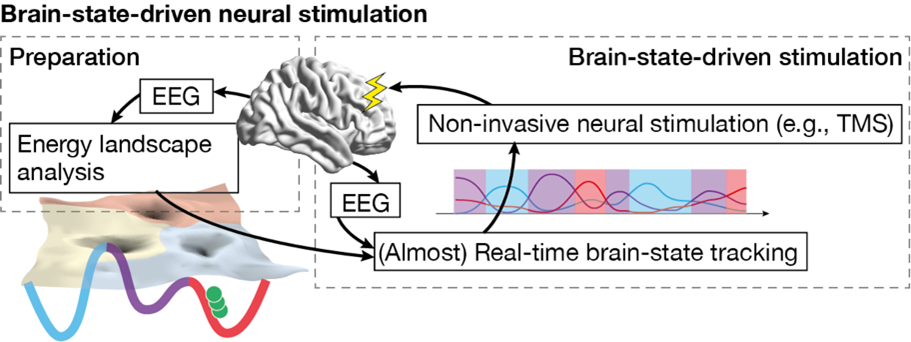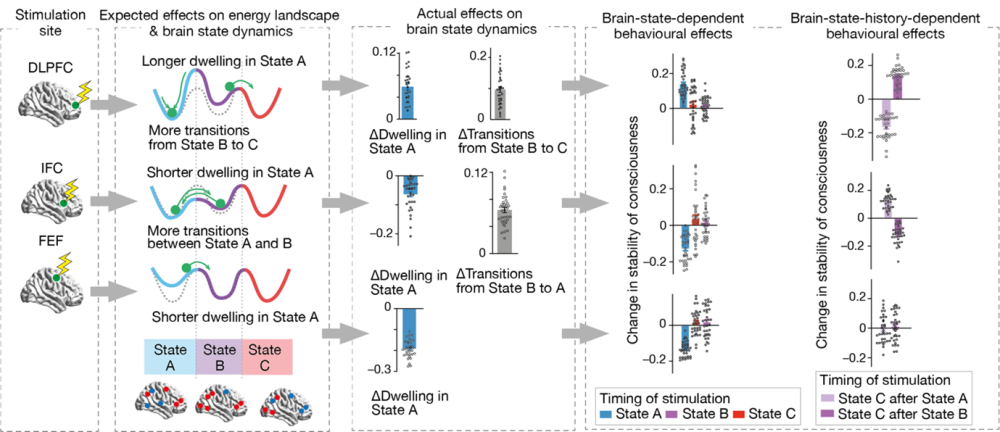In new work published in the journal eLife, a researcher at the International Center for Neurointelligence(IRCN) at The University of Tokyo showed that visual consciousness, the mental awareness of what our eyes see, is regulated by particular patterns of neural activity in the prefrontal cortex, the brain's executive control center. The results resolve an ongoing controversy by revealing that specific brain state patterns organize conscious perception.
Scientists believe that the continuous flux of brain activity called neural dynamics is a key to understanding visual consciousness. Still, the identification of the specific activity patterns associated with awareness had been elusive. Using physiological recordings, researchers scan the brains of human subjects viewing visual illusions such as a line cube that seems to shift its spatial arrangement, or the silhouette of a pirouetting dancer who abruptly begins to spin in the opposite direction to probe the neural mechanisms of consciousness. In these studies, several prefrontal areas were activated during switches in the subjects' visual awareness.
However, whether the effect of these prefrontal activities were responsible for the perception or were merely a side effect remained unknown. In prior studies, when the activity in the identified prefrontal areas were inhibited by transcranial magnetic stimulation (TMS), the percept stability during tests of bistable visual perception was not significantly affected. Based on these observations, those researchers concluded that prefrontal activity was not a cause but merely a consequence of the subjects' fluctuations in visual consciousness.
IRCN Associate Professor Takamitsu Watanabe addressed this dilemma by devising a new brain stimulation system. By exposing human subjects to bistable visual illusions during electroencephalography (EEG) driven TMS inhibition of prefrontal cortex, he demonstrated that the three prefrontal areas are causally responsible for behavioral visual consciousness. Prefrontal area involvement was difficult to detect without such simultaneous tracking of brain state activity dynamics linked to TMS brain stimulation with a specific timing pattern.
This is the first report of brain state-dependence in visual consciousness indicating that the prefrontal cortex plays a causal role in bistable perception. Moreover, the dynamics of the changing visual awareness are determined by brain states that can be decoded from whole-brain activity patterns. These findings imply that a full understanding of vision and likely other behaviors of perception and cognition will require monitoring neural state dynamics.
Watanabe proposes that this study opens the possibility that his newly-developed TMS-based neural stimulation system may be useful to control cognitive flexibility in other behaviors. Future clinical applications might allow mitigation of cognitive and perceptual rigidity in autistic individuals, hyperflexibility of attention in ADHD individuals, and general cognitive inflexibility seen in other neuropsychiatric patients. To realise these clinical applications, he plans to improve the brain stimulation system to study cognition in a variety of populations.
Reference: Watanabe, T., Causal roles of prefrontal cortex during spontaneous perceptual switching are determined by brain state dynamics. eLife, November 2021; DOI:10:e69079

Figure 1. Brain state-driven neural stimulation system.
A non-invasive neural stimulation system to administer transcranial magnetic stimulation (TMS) only when the brain shows a specific activity pattern. The system was used to track brain activity patterns with offline and online electroencephalography (EEG) analyses.

Figure 2. Brain state pattern history-dependent analysis.
Causal roles on the dynamics of visual consciousness were identified for three prefrontal areas—dorsolateral prefrontal cortex (DLPFC), inferior prefrontal cortex (IFC) and frontal eye field (FEF). Neural stimulation at a particular timing over these frontal regions changed their activity pattern for the fluctuation of perceptual awareness and brain state dynamics.


